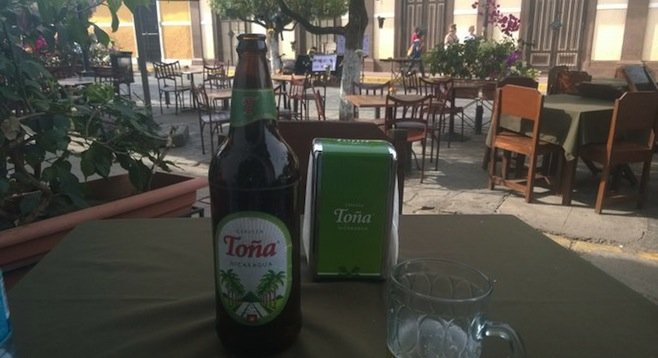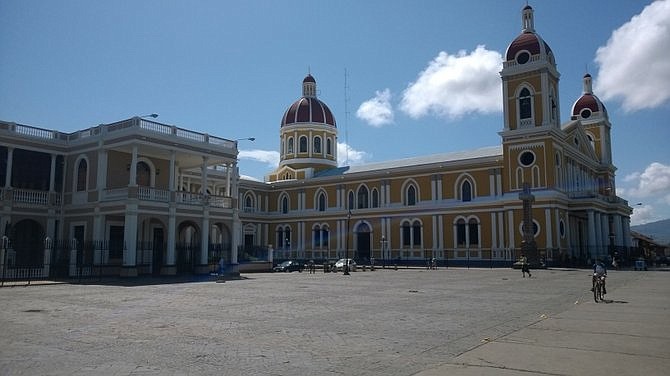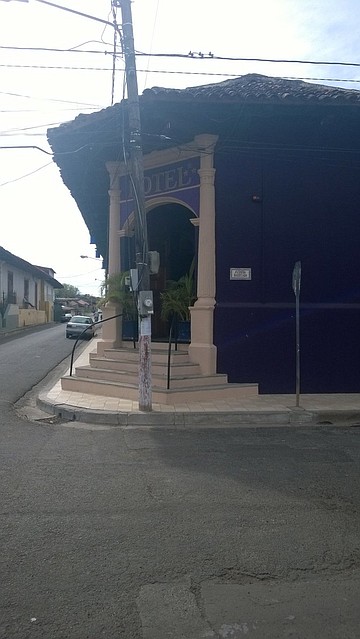 Facebook
Facebook
 X
X
 Instagram
Instagram
 TikTok
TikTok
 Youtube
Youtube

Nicaragua may be one of the continent's last untarnished jewels that hasn't been flooded with foreign tourism. Lying just to the north of Costa Rica, it can be managed on an extremely low budget.
If you're traveling without pre-arranged plans, getting out of the capital, Managua, may not be the easiest. Managua has plenty to offer, but venturing to one of the colonial cities of León or Granada is a must.
Arriving at the Augusto C. Sandino International Airport in Managua, you might expect shuttles and buses departing for what should be booming tourist cities. As I learned the hard way, this is not so.
Granada, one of the oldest cities in the Western Hemisphere, is about an hour ride from the airport. With no buses or shuttles regularly traveling to Granada (unless you prearrange or pay high dollar for a private shuttle), you have few options. Taxis are cheap, as you can negotiate a taxi for around $30USD for the hour ride to Granada. You can also take a taxi to the UCA bus terminal in the city, which will cost you about $10.

Once you arrive at UCA, there are shuttles to and from Granada at least every hour. This will cost you a mere few dollars and drop you off near the central park.
At some point it's beneficial to exchange into the local currency, the cordoba. One United States dollar is worth almost 26 cordoba. U.S. dollars are generally accepted, but you'll stand a lesser chance of getting ripped off if paying in the local currency.
When traveling to Nicaragua, it's advised to at least have an understanding of basic Spanish, as English is not spoken everywhere. Nicaragua shares strong ties, culturally and politically, with Cuba and Venezuela, keeping American influence out of much of the nation.
After you have figured out your way of traveling to Granada, sit back and enjoy the ride. The scenery and lively roads you will see on the way are beyond interesting. You will see cows and horses tied up to posts along the highway to feed, as well as full families somehow managing to cram rides on single seat motorcycles.

Upon my arrival in Granada, I checked into Hotel el Club by recommendation of Manny, my shuttle driver. The hotel was $42 a night and was in a great location. The rooms do not have air conditioning, but most of the year a fan will do in Granada.
I was pleasantly surprised at the lack of tourists roaming the streets of the colonial city. Maria, the bartender at the hotel, suggested a walk to the central park and to continue east on the pedestrian street Calzada to see more of the city.
Calzada has a long line of cafes, restaurants, and bars. Here you can pick up a local Nicaraguan cigar and the local favorite beer, Toña, for a few bucks. Beer often runs under the equivalent of a U.S. dollar and meals often are less than $7, even in the main city square. There are a few American-themed bars playing music in English, but stopping at these will likely cost you more.
Many talk about the threat of crime in Nicaragua, but it consists of mostly petty crime. The nation is not plagued with gangs as some other nations in Central America are. Basic travel precautions, such as not wearing jewelry or flashing money, will likely prevent any incidents.
After a few days I was tempted to lengthen my stay in Granada, simply for the atmosphere, great food, and cheap prices. However, I had to get back to Managua.
Getting back has its options as well. You can find a taxi, but some local drivers prefer not going to the city. The other option is taking a shuttle from the station just south of the central park. When you approach the station you will hear men yelling UCA (pronounced "ooo-k-aa").
These shuttles will cost you less than a dollar, but are actually a local transit that stops a couple dozen times on the way back. I was hesitant at first, but it was well worth the lively trip.
If you are packing lots of luggage, you may have to go for the taxi, as the shuttle buses are packed, picking up and dropping passengers all the way to the city.
Returning to the UCA station in Managua is a good takeoff point if you decide to explore more of the country, as buses and shuttles leave frequently for multiple destinations.


Nicaragua may be one of the continent's last untarnished jewels that hasn't been flooded with foreign tourism. Lying just to the north of Costa Rica, it can be managed on an extremely low budget.
If you're traveling without pre-arranged plans, getting out of the capital, Managua, may not be the easiest. Managua has plenty to offer, but venturing to one of the colonial cities of León or Granada is a must.
Arriving at the Augusto C. Sandino International Airport in Managua, you might expect shuttles and buses departing for what should be booming tourist cities. As I learned the hard way, this is not so.
Granada, one of the oldest cities in the Western Hemisphere, is about an hour ride from the airport. With no buses or shuttles regularly traveling to Granada (unless you prearrange or pay high dollar for a private shuttle), you have few options. Taxis are cheap, as you can negotiate a taxi for around $30USD for the hour ride to Granada. You can also take a taxi to the UCA bus terminal in the city, which will cost you about $10.

Once you arrive at UCA, there are shuttles to and from Granada at least every hour. This will cost you a mere few dollars and drop you off near the central park.
At some point it's beneficial to exchange into the local currency, the cordoba. One United States dollar is worth almost 26 cordoba. U.S. dollars are generally accepted, but you'll stand a lesser chance of getting ripped off if paying in the local currency.
When traveling to Nicaragua, it's advised to at least have an understanding of basic Spanish, as English is not spoken everywhere. Nicaragua shares strong ties, culturally and politically, with Cuba and Venezuela, keeping American influence out of much of the nation.
After you have figured out your way of traveling to Granada, sit back and enjoy the ride. The scenery and lively roads you will see on the way are beyond interesting. You will see cows and horses tied up to posts along the highway to feed, as well as full families somehow managing to cram rides on single seat motorcycles.

Upon my arrival in Granada, I checked into Hotel el Club by recommendation of Manny, my shuttle driver. The hotel was $42 a night and was in a great location. The rooms do not have air conditioning, but most of the year a fan will do in Granada.
I was pleasantly surprised at the lack of tourists roaming the streets of the colonial city. Maria, the bartender at the hotel, suggested a walk to the central park and to continue east on the pedestrian street Calzada to see more of the city.
Calzada has a long line of cafes, restaurants, and bars. Here you can pick up a local Nicaraguan cigar and the local favorite beer, Toña, for a few bucks. Beer often runs under the equivalent of a U.S. dollar and meals often are less than $7, even in the main city square. There are a few American-themed bars playing music in English, but stopping at these will likely cost you more.
Many talk about the threat of crime in Nicaragua, but it consists of mostly petty crime. The nation is not plagued with gangs as some other nations in Central America are. Basic travel precautions, such as not wearing jewelry or flashing money, will likely prevent any incidents.
After a few days I was tempted to lengthen my stay in Granada, simply for the atmosphere, great food, and cheap prices. However, I had to get back to Managua.
Getting back has its options as well. You can find a taxi, but some local drivers prefer not going to the city. The other option is taking a shuttle from the station just south of the central park. When you approach the station you will hear men yelling UCA (pronounced "ooo-k-aa").
These shuttles will cost you less than a dollar, but are actually a local transit that stops a couple dozen times on the way back. I was hesitant at first, but it was well worth the lively trip.
If you are packing lots of luggage, you may have to go for the taxi, as the shuttle buses are packed, picking up and dropping passengers all the way to the city.
Returning to the UCA station in Managua is a good takeoff point if you decide to explore more of the country, as buses and shuttles leave frequently for multiple destinations.
Comments